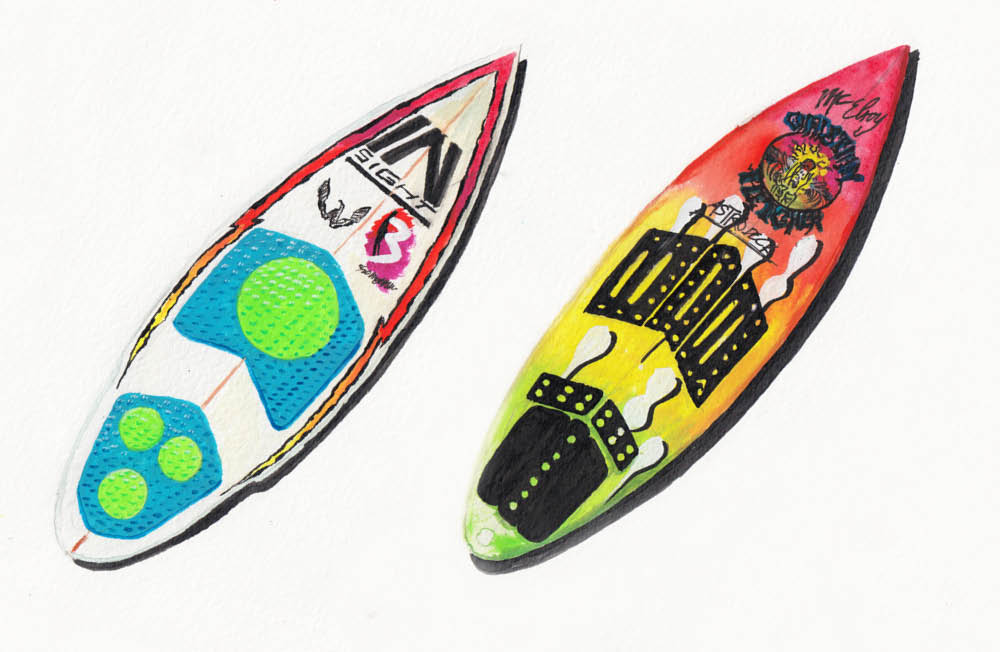The Short History Of Deck Grip
In year 11 biology there was this dreary debate about Lamarckian evolution (form follows function), and Darwinian evolution (form determines function). We eviscerated a sad-looking frog. None of us were sure what it all meant: we just wanted to go surfing.
But there must be something in it, because surfboard traction spent years in a tangle of form, function and that random interloper, fashion. Adhesive traction always seemed a good idea: why mess with the constantly shifting grip co-efficients of wax when you could render the traction surface permanent and stable by sticking something grippy onto the deck? But suspicion abounds when surfers are confronted with change. Fashion refused to yield, and Lamarck held all the aces.
In 1976, American Herbie Fletcher had started fooling around with a polyurethane elastomer foam. This could have led him to invent the Pool Noodle, but instead, he found that by blowing the foam in to flat sheets, then sanding the top layer off, he exposed open cells that created suction under pressure. Voila! Adhesive deck grip was born. Its less sociable properties, such as tearing hair and skin off the chest of the unfortunate surfer, took a little while to emerge under testing. If the rash vest had been invented three years earlier than it was, countless nipple shreddings could’ve been avoided.
Owing to this minor blind spot, grip was applied down the length of the board, catering to front foot as well as back. A quick scan through the surf mags of the early 80s reveals the believers: in October 1980, Surfer magazine ran a cover shot of Greg Mungle in extremis, midway through a giant forehand hack, with the entire top side of his board covered in adhesive grip. Skate culture may have had a hand in this: no-one would’ve dreamed of limiting griptape to only the back foot of the board.
As designers pushed boards through two fins then three, the need for a back foot point of reference grew apace. The “Astrodeck” team in 83 boasted Wes Laine, Willy Morris, Larry Bertlemann, Gary “Kong” Elkerton, Chappy Jennings, Shaun Tomson & Rabbit. But front foot grip stuck in there: among the adherents were Ces Wilson, Stuart Thomas, Matt Cattle, and Dooma Hardman, who won a World Title on full length grip in 87. As late as 88, when people were already dreaming of getting live betting odds on mobile phones the size of a frozen lasagne, Barton Lynch won a World Title with full deck grip, and accordingly, no chest hair.
But Herb had more tricks up his Wizard’s Sleeve. He saw that his grip product was difficult to apply and that the majority of surfers were habituated to using wax. So he took a cue from punk fashion and started cutting his grip into dots, checkers and day-glo shards. Over here, Gorilla Grip were pumping the “Centre Deck” and “3D Dial Pad”. Herb’s mob responded with kicks, arches and ripples (inspired by running shoes) for superior grip and foot positioning. The promotional terminology that went with these designs evolved even faster than the designs did: wax is still wax (you want cold water or tropical mate?), but deck grip is now a “patented multigridlock high performance foot pad”.
Much like the humble thong, there’s now a market in questionable add-ons, aimed at value-adding these flat rubber slabs: artwork, wax combs, fin keys, beer openers, even shark repellents. But application remains the number-one grievance among surfers. The instructions clearly warn you to give it at least 24 hours, but sticking the stuff onto the board is a job that’s frequently left even later than screwing in the fins. In your hurry to get out of the car/off the boat/away from domestic chores, how many times have you peeled the back, slapped it on, given it a speculative squish with your palms and then watched it float away after the first decent wipeout? Say what you like about wax, but it’s got a commendable tendency to stay attached to the board.
